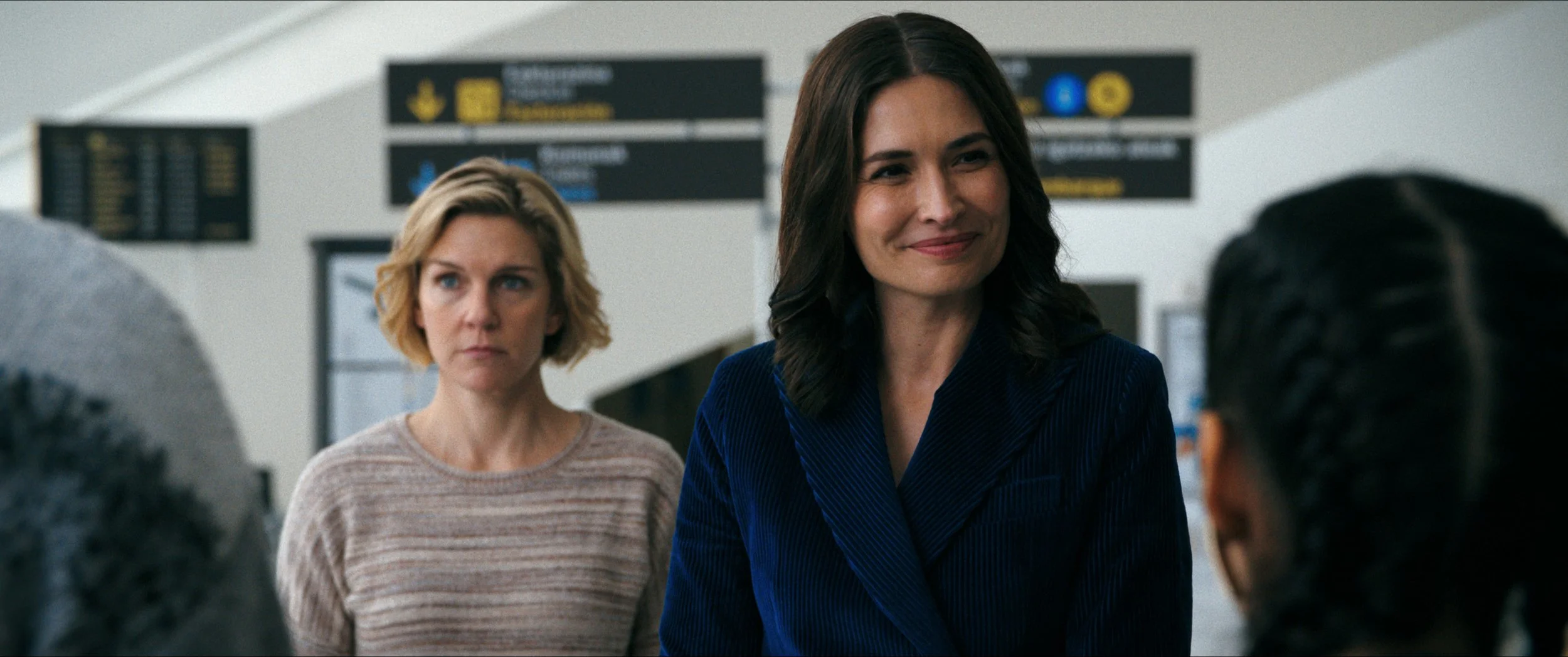Pluribus: Vince Gilligan’s latest, one angry woman’s fight against a world that’s 'Breaking Glad'
By Liam Lacey
Rating: A
You can almost feel the hot collective breath of fan anticipation for Pluribus, Vince Gilligan’s first new show in a decade, following the essential Breaking Bad (2008-2013) and its entertaining spinoff, Better Call Saul (2015-2022).
Pluribus (styled as Plur1bus in promotional materials), a science fiction series, is also a callback to Gilligan’s early work on Chris Carter’s The X Files, which helped promote urban legends and conspiracy theories into the mainstream.
Rhea Seehorn and Karolina Wydra in Pluribus
Fear not, fans. Pluribus starts strongly out of the gate, offering an addictive combination of dark humour, attention-grabbing camera work from Marshall Adams, dramatic landscapes, and a playful spooky score, anchored by a captivating performance by Better Call Saul’s breakout star, Rhea Seehorn as a curmudgeonly romance novelist who becomes the last hope for humanity.
“I’ve seen this movie. We’ve all seen this movie and it does not end well,” declares Carol Sturka (Seehorn) in the show’s second episode (the first two episodes of the nine-part series premiere on Friday on Apple TV+). The warning has a specific dramatic and thematic purpose (there are 13 international survivors who might save humanity, a tidy Jesus and the Apostles bakers’ dozen). Her speech also signals that Pluribus is not just another scary movie, but a knowing metafictional take on the alien invasion or zombie apocalypse genre, through Gilligan’s cockeyed lens.
As the first episode begins, a group of astronomer nerds (I can call them that because one of them has a sticker “Nerd” on his laptop) are waxing giddy about a strange signal from deep space that, on their computer screens, looks like a bar code.
Meanwhile, in another city, a group of middle-aged women are attending Carol’s book reading at a Barnes and Noble, as she reads lusty tripe about a pirate lady having her way with a sinewy sailor. After the book signing, we soon learn that Carol disdains her fans and her hetero-fantasy novels. But at least they have earned her and her retired academic partner, Helen (Miriam Shor) enough money for travel and a Spanish revival monster home on an Albequerque cul-de-sac on the edge of the desert.
The two worlds soon collide later that night. Triggered by a combo of events — alien interference, a lab leak, altered RNA — most of the human race ends up being joined into one big hive mind. The transition is a bit rough — people freeze in their footsteps, have seizures and collapse — but most of them get better. You might call what happens next a case of “Breaking Glad”: Wars end and all crime stop. The transformed humans are unfailingly honest, peaceful and so agreeable they often speak in unison.
They are also accommodating to the handful of “unjoined” humans, catering to their every whim. For some of the old humans, this is a chance to act out lurid fantasy scenes, using the new humans as playthings; for others, such as Carol, who was never all that fond of nice people, the experience is hellishly isolating.
The script touches on several topical themes here, political and ethical. Some of the script mocks the conformism of politically precious left, with pokes at vegetarians and safe speech advocates. And the paradox that enforced peace and love is a kind of violence.
But the most conspicuous target here is the encroachment of Artificial Intelligence into human life. The new improved humans, anxious to never give offense, give answers to questions that sound like paragraphs from Wikipedia, and speak in a tone that resembles the infuriatingly patient manner of automated call center voices. (You call Carol’s personal 24-hour line for a sample.)
In our real world, tech specialists have begun raising an alarm about how AI is strategically sycophantic. (For example, I just asked ChatGTP: “Why is AI so sycophantic?” and its answer began: “That’s a sharp and important question.”) Of course, the spectre of a brain-dead utopia is familiar, to the point where AI could probably write this plot for us.
A less obvious theme of the series, related to the COVID pandemic which saw the boom in streaming series, is how we face isolation and boredom. Traditional episodic TV feeds you a jolt of pleasure or excitement shock every few minutes to keep you from flipping channels before the next commercial.
In contrast, when you lock into a film for two hours, you are conscious of time’s pressure. Gilligan, one of the pioneers of the new streaming media, makes expensive and expensive looking TV (Pluribus purportedly cost around $15-million an episode) but he isn’t afraid, like a filmmaker, to slow things down and delay gratification, to digress.
One of the series’ stand-alone episodes is, essentially, a road trip through South America, unfolding like a fragmented dream. Another focuses on Carol just trying to kill time, singing tunelessly, practicing golf, wandering through an empty art gallery, drinking or declining to drink.
Yet, even when nothing much is happening but there is a constant trickle of rewards, an unusual close-up, a furtive eye movement here, a funny pop music cue, a distorted reflection in a hub cap, or a helicopter appearing through a swarm of bugs.
This movie does not end well, warned Carol, though how Pluribus concludes is still undetermined. The series will run for at least two seasons but Gilligan has said it might go to a third or more. That’s because he has the human freedom to be vague.
This review is based on the first seven episodes of Pluribus Created by Vince Milligan, starring Rhea Seehorn, Karolina Wydra, and Carlos-Manuel Vesga and Samba Schutte. The first two episodes of the series are available on Friday, Nov 7, with new episodes each Friday until Dec. 26.


